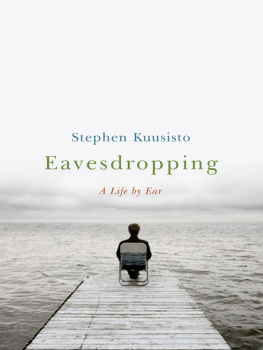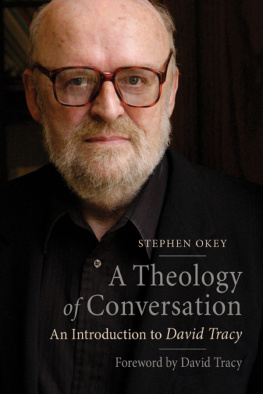DO NOT INTERRUPT
Do Not Interrupt
A Playful Take on the Art of Conversation
Stephen Kuusisto

For Marty Carver, Ed Stone, and Gary
Whittington, symposiasts
STERLING and the distinctive Sterling logo are registered
trademarks of Sterling Publishing Co., Inc.
10 9 8 7 6 5 4 3 2 1
Published by Sterling Publishing Co., Inc.
387 Park Avenue South, New York, NY 10016
2010 by Stephen Kuusisto
Distributed in Canada by Sterling Publishing
c/o Canadian Manda Group, 165 Dufferin Street,
Toronto, Ontario, Canada M6K 3H6
Manufactured in the United States of America
All rights reserved
Sterling ISBN 978-1-4027-6696-1
For information about custom editions, special sales,
premium and corporate purchases, please contact
Sterling Special Sales Department at 800-805-5489
or specialsales@sterlingpublishing.com.
CONTENTS
one
The Principle of Simultaneous Elevations
two
Loves Body and Other Mysteries
three
A Symposium Remembered after Twenty Years
four
Free and Easy
five
Talking to Yourself
six
Having a Party with Thomas Aquinas
seven
Times of Joy

In times of joy, all of us wished
we possessed a tail we could wag.
W. H. Auden
Two men in overcoats sit in a garden in upstate New York in early spring. Snow has gone but the trees are not yet green. The thin oaks and birches have started to resound with birds.
The men are in their early thirties, both poetry professors at the local college, and theyre wearing vintage fedoras and drinking champagne from paper cups. They are oblivious to their sooty lawn chairs and the lingering cold of early April.
The first man says, I was green at birth, then suddenly I turned gold as a dancing shoe. And this afternoon I am happy with the moon rising in the east and feel I need nothing more. What a life Ive had! What peculiar night blooming flowers are in my possession!
The second says, Mother dined out for years on the Indian railway station trick. Hes alluding to his childhood in India. His mother would induce laughter from British colonial society by imitating all the sounds of an awakening rural railway station.
The first says, I know a man in Helsinki who by day works as a respectable banker. His children go to the university; his wife writes for a leading newspaper. But thats only part of the story. On the weekends this man of business goes to the woods and talks to his personal rock. He has done this all his earthly life. Every man or woman in Finland finds his own woodland library if theyre lucky.
Did you ever climb a mountain with someone you love? asks the second man. No one who hasnt done this can fully understand the superior nature of bread and the touch of loves hand in the high altitudes.
In this way the two men share their respective anecdotes of joy until the sun goes down.
Oh yes, and they never interrupt each other.

The Principle
of Simultaneous
Elevations
My first real conversation was crazy. Im guessing that yours was too. Heres how it went:
Me (four years old): Why is the monkey in the cupboard?
Finnish Babysitter (forty-two years old): Because the monkey was bad.
Me: Monkeys arent bad!
Babysitter (Ill call her Kirsti): Oh yes, the monkey was bad. He wont go to sleep.
Me: How can he sleep in a cupboard?
Kirsti: Because hes got no one to talk to in there.
Me: He can talk to himself, you know!
Kirsti: Go to bed!
Me: I can hear the monkey talking in there!
Kirsti: Whats he saying?
Me: He wants to go to the railroad station.
Kirsti: Why does he want to go to the railroad station?
Me: Because he needs to go to the ice cream stand.

Conversation differs from talk.
Talkers are basically engaged in soliloquy. A talker generally doesnt notice that you exist.
A talker will only stop talking after youve expired and of course even this isnt certain.
Im reminded of the slightly subversive and funny short story by Saki (H. H. Munro) in which the husband drones on and on to his wife about the empty nonsense of life and after many pages of monologue he finally stops talking and finds that his wife is dead in her armchair.
Yes, but as the Greeks well knew, people who are having a conversation are suddenly equals. We could call this the principle of simultaneous elevations, for as the people converse they are experiencing mutually aroused curiosities. In my Helsinki flashback above, Kirsti realizes that our bedtime narrative about the stuffed monkey is turning into a little, unforeseeable mystery. Heres where it happened:
Me: I can hear the monkey talking in there!
Kirsti: Whats he saying?
Me: He wants to go to the railroad station.
Kirsti: Why does he want to go to the railroad station?
Me: Because he needs to go to the ice cream stand.
Strictly speaking a conversation is a moment of shared language marked by a mutually rewarding sense of surprise. Poetry, said Ezra Pound, is news that stays news. Pound was thinking of news less as dull journalism and more as surprisea news flash. Kirsti and I were sharing the news. Monkeys can be bad. Monkeys talk to themselves about railway kiosks.
How do you know when youve had a conversation instead of a talk?
Heres a good description of what happens when youve had a real conversation. This is from a letter written by Annie Sullivan, Helen Kellers famous teacher. Annie describes how her friend the inventor Alexander Graham Bell (who was a great benefactor of the deaf) could make her feel when they spoke together:
I never felt at ease with anyone until I
met him. I was extremely conscious of my
crudeness. Dr. Bell had a happy way of
making people feel pleased with themselves.
After a conversation with him, I felt released,
important, communicative. All the pent-up
resentment within me went out...

Conversationalists are always equal to their partners, though the partners may not know this as the conversation begins. This equalizing effect is one of the shy, unasked-for prizes of sharing our imaginations. The ancient Greeks called this mutual engagement of minds a symposium, which essentially means human beings in a state of being connected. When Socrates and his friends gathered their goal was to share their curiosity and wonder about the mystery of being alive. News that stays news.
As Ive already remarked, conversation differs from talk. Talkers are generally interested in selling us something (a pathology, a polemic, or real estate, or deodorant liners for your sneakers). The talker loves cell phones, text messaging, and tweeting because these are media of assertion. Talkers are oddly Victorian: they think theres a right way and a wrong way to get through the hurried minutes. A talker is a perpetual adolescent. Just yesterday, a college girl sitting next to me on a bus sputtered into her mobile phone, I cant believe she was wearing those pantsshes so fat! Hearing her I was reminded that talkers assert themselves without evident curiosity: they talk from habit, their words securing them like cotton batting.
Next page












